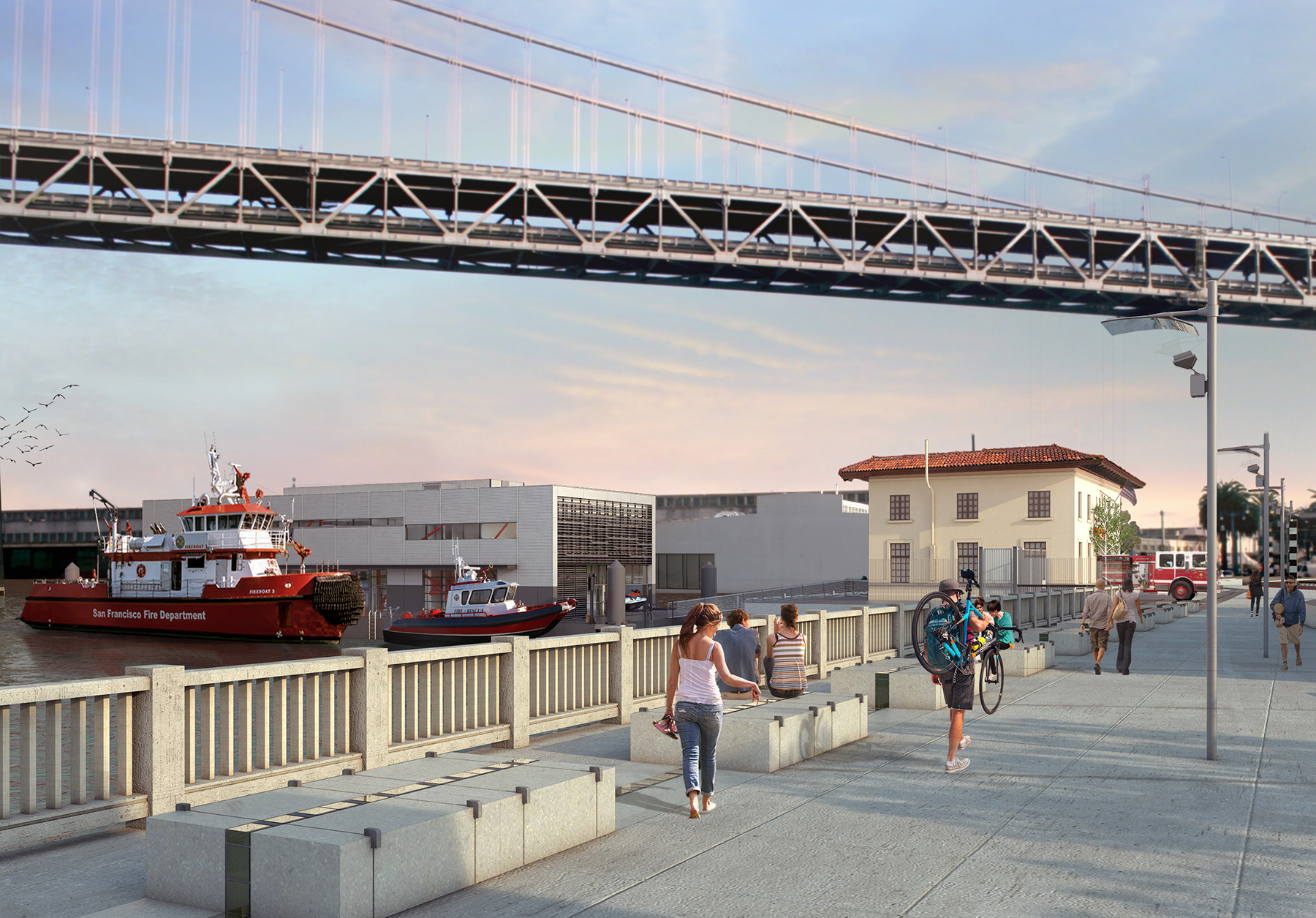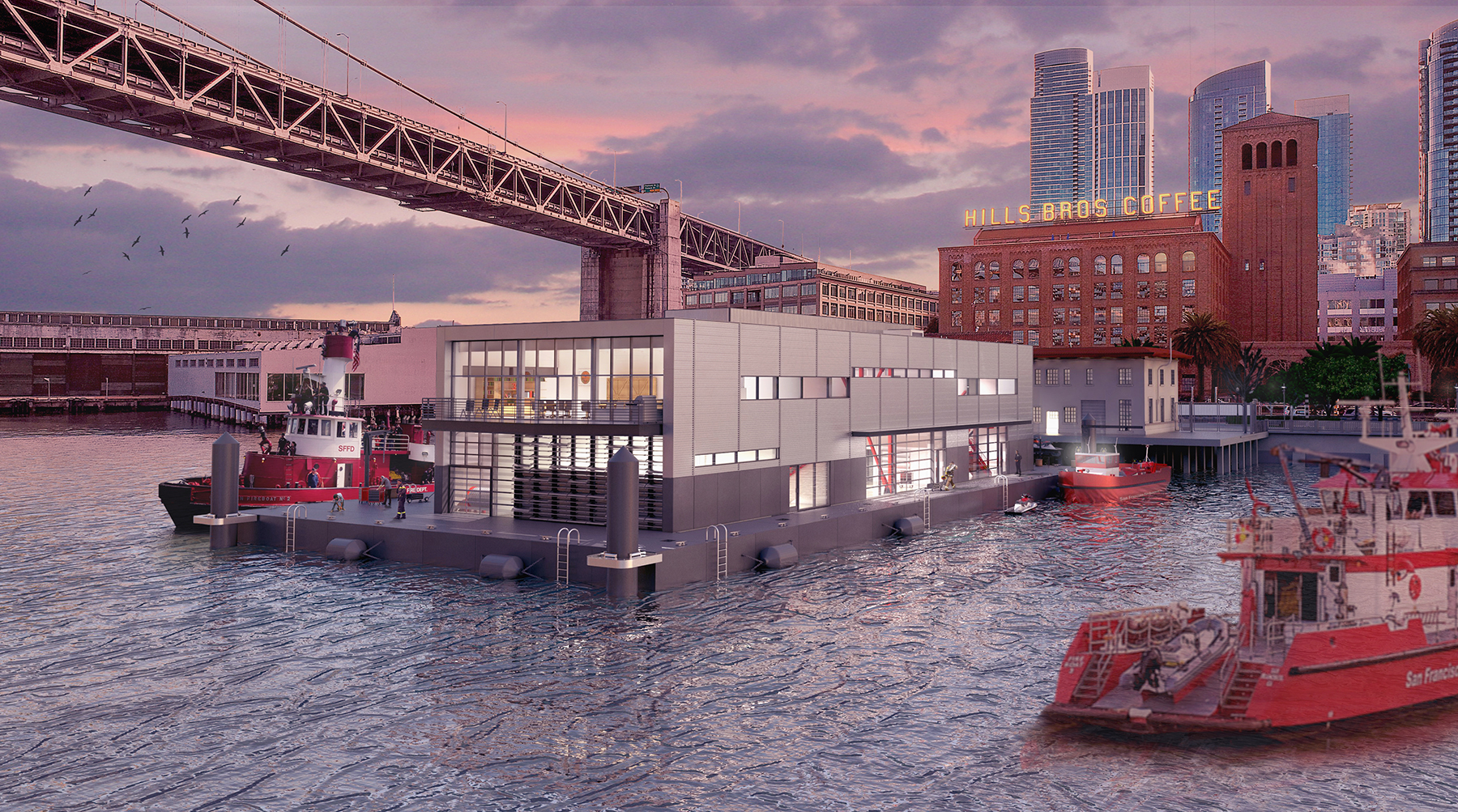By Catherine A. Cardno, Ph.D.
An unusual two-story, 14,800 sq ft fire station will soon be operational in San Francisco. Slated to open by the end of the year, the fire station is being built on the water, rather than alongside it. It is an expansion of Fire Station 35, which began operations in 1918 and is the oldest fire station operating in the city.
The existing historic Station 35 building will continue to house the specially built, operational firetruck — both narrower and shorter than modern rigs — that currently calls it home, but the remaining fire station operations will be relocated to the new floating building.

Historic location
“Given the project’s proximity to the National Register (of Historic Places)-listed (Central) Embarcadero (Piers) Historic District and its connection to the existing Fire Station 35 bulkhead building at Pier 22 ½ — a city landmark — the floating fireboat station was designed to invoke the spirit of historic past without mimicking historic styles,” says Alan Kawasaki, co-founder and principal at Shah Kawasaki Architects, the architecture firm for the project. (The existing Fire Station 35 is designated as San Francisco Landmark No. 225 by the city.)
“While the orientation and industrial aesthetic of the floating fireboat station were inspired by the historic pier shed structures, the design is of our time,” Kawasaki says. “This is in keeping with the historic preservation guidelines of the various agencies and organizations that participated in the design review process.” These include SF Planning, the San Francisco Bay Conservation & Development Commission’s Design Review Board, the Port of San Francisco’s Waterfront Design Advisory Committee, San Francisco’s Historic Preservation Commission Architectural Review Committee, and San Francisco Heritage.
New building
The new two-story building is built atop a 95 ft by 173 ft steel float that is moored at its corners with four 125 ft long, 60 in. diameter vertical steel piles and is designed to withstand earthquakes, storms, and sea level rise while remaining fully operational. It is immediately adjacent to the historic Station 35 building, accessible via ramp from the station by firefighters and via vehicle ramp from the road for ambulances.
The $39.9 million floating station will provide berth for the city’s three fireboats, the Phoenix (1954), the Guardian (1951), and the St. Francis (2016). These boats are crucial elements in the firefighting arsenal of a city surrounded on three sides by water and that was all but leveled in a catastrophic earthquake and fire in 1906. It will also house a new fire station command center; repair, maintenance, and fabrication facilities for the fireboats; and residential areas for those on duty.
(The city’s fireboats have multiple land and water roles — not only do they respond to waterborne issues, such as capsized boats or injured people, they also are responsible for fires inaccessible to other vehicles that might occur on area infrastructure, such as on the San Francisco-Oakland Bay Bridge. The boats are also floating fire hydrants capable of pumping freshwater or saltwater to fight fires in the city at a rate of up to 18,000 gal./minute, depending on the boat. This is a particularly crucial task if the city’s waterlines are severed in a major earthquake.)

“The lateral system was chosen to prevent any excessive deflection on the structure,” says a statement made to Civil Engineering magazine by the building’s structural engineering firm of record, Pannu Larsen McCartney. The steel building’s lateral system is composed of buckling restrained braced frames in the longitudinal and transverse directions. The columns and braces are connected to one another by gusset plates.
“After the initial investigation, the design team found that seismic was not the governing load case considering that the earthquake design motions are mitigated by the long period of the floating structure,” the statement from PLM says. ‘The surrounding water also provides some damping. Wind and 100-year storm were the governing load cases in the building’s structural design.”
“The gravity system of the building’s floors is composed (of a) 3 in. metal deck with 3 in. of lightweight concrete fill, supported on wide flange composite beams and girders connected to hollow structural steel sections that act as columns,” says PLM. “This system was chosen as a best fit for good performance based on the load demands and (to) help us with many construction requirements.”
The design accommodates the potential float deformation caused by seasonal water temperature changes, which will add stresses to the entire building. It also accommodates stresses to the building’s perimeter columns and potential building tilt that is introduced by various types and sizes of waves — both daily, seasonal, and storm — as well as wind and seismic loads, according to PLM.
Steel piles
The steel piles that will allow the steel float — and building — to rise up and down with the tides, storm surges, and sea level rise are also designed to accommodate sea wall lateral movement in an earthquake, according to a statement made to Civil Engineering by Liftech Consultants, the engineer of record for the float, steel piles, a new steel pier, and the ramp between the pier and float.
“After an involved analysis of the rock sea wall embankment sliding on the relatively weak soil layer beneath it, the piles were designed to deform plastically without buckling and remain functional after the design earthquake,” says Liftech. “The seismic loads on the steel float piles do not control over the storm loads, so the float piles were designed for storm loads.”
The comfort of occupants was also taken into consideration. “(A) significant challenge was to design a robust system with strong and stiff piles able to resist the wind, wave, and berthing loads while also mitigating the float movements for the firefighters who would be living on it during their shifts,” says Liftech. “We designed a dampener system composed of a variety of reinforced rubber pads sandwiched between steel plates to provide significant cushioning, reducing the impact of the float on the piling by up to 90%.”
The existing piles are designed to accommodate the expected sea level rise within the next 50 years; should that be exceeded, the pier superstructure has been designed such that it can be removed with a floating crane and pile extensions then added to the existing piles. The pier superstructure can then be reset onto the extended piling.
Project credits:
Project manager San Francisco Public Work
Design-builder Swinerton-Power, a joint venture
Architect Shah Kawasaki Architects
Structural engineer of record for building Pannu Larsen McCartney
Structural engineer of record for float, piling, pier, and ramp Liftech Consultants



